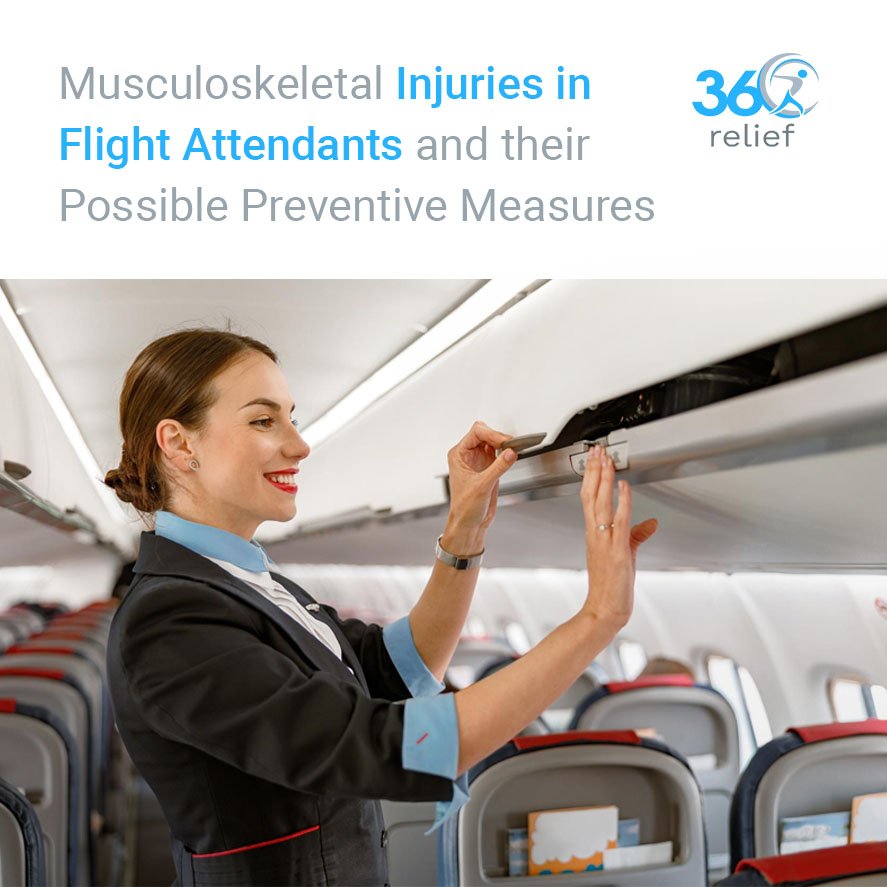
Make This Christmas Pain-Free: 10% Off on Supportive Wear!
Holidays are coming, which means that let’s welcome them with joy, laughter, and, of course, some comfort! At 360 Relief,

Due to the nature of their jobs, flight attendants are susceptible to various musculoskeletal injuries. Their job usually involves repetitive movements, carrying heavy loads or luggage, standing in awkward postures, and others. All these actions may put excessive pressure or strain on various muscles and joints, causing musculoskeletal injuries. As well as this, flight attendants may also require sitting or standing for a prolonged time, causing circulation problems in the lower legs. Understanding the causes of these injuries is crucial to reduce the chances of injuries.
Here in this article, we are going to discuss the common injuries in flight attendants along with their causes and symptoms. As well as this, we have also discussed the potential preventive measures, suggested by experts, to help you get a safe and injury-free job experience. So; let’s begin our discussion here:
Table of Contents
ToggleThe following are the common musculoskeletal problems usually faced by flight attendants during their duty times. Understanding the causes and symptoms of these injuries may help you avoid the chances of injuries to get a safe duty experience:
One of the most common musculoskeletal injuries that is complaint by flight attendants is lower back pain. Lifting heavy luggage repeatedly into overhead compartments or during cargo handling can be the primary cause of lower back strains. As well as this, flight attendants need to maintain a forward-bent posture while conducting a safety check and serving passengers. The posture may put excessive strain on the lower back, causing lower back pain.
The common symptoms of lower back problems may include a dull and aching sensation in the lumbar region. The pain may worsen during particular activities, including lifting, bending, and prolonged standing or sitting. In some severe cases, the pain may also radiate to the lower extremity due to nerve compression.
In order to prevent lower back issues during flights, airlines must provide flight attendant staff with ergonomic equipment or proper training. This training can include teaching the staff proper lifting techniques. As well as this, emphasising the importance of maintaining a neutral posture of the spine during performing various tasks is also crucial. Taking regular breaks and stretching exercises are important to alleviate strain on the lower back.
Additionally, wearing lower back support braces is recommended to bear the impact of strain on the lower back. You must also follow any other instructions suggested by your healthcare professionals to reduce the chances of injuries.

During serving passengers, storing or retrieving items from the compartments, and performing other lifting tasks, flight attendants may require to reach overhead. This repetitive overhead reaching may cause excessive pressure or strain on the muscles of the shoulders or neck.
Straining shoulders or neck may result in soreness, stiffness, and restricted range of motion. Pain in the neck or shoulder may also worsen during overhead movements or when carrying heavy loads.
The basic preventive measure is to provide flight attendant staff with adjustable trolleys and assisting devices to reduce overhead lifting. As well as this, the staff must maintain proper posture during these overhead activities. Healthcare professionals suggest wearing shoulder support braces or neck support braces to manage or reduce the chances of straining the shoulder or neck.

Flight attendants during their duties are usually involved in repetitive hand and arm movements. These movements include opening overhead compartments, serving meals, and handling beverages. These repetitive movements, sometimes, lead to overuse hand and arm injuries.
The overuse injuries of the hand and arm may make you feel pain, tingling sensation, or weakness in your hands or arms. Performing activities, like grasping and holding objects, sometimes may become challenging.
The primary preventive measure to reduce the chances of hand and arm pain is to provide flight attendants with ergonomic tools and equipment. Using ergonomic tools or equipment does not put excessive strain while overusing or performing repetitive movements. Flight attendants may also take regular breaks and perform stretching exercises. As well as this, using hand support or wearing arm sleeves helps keep your arm safe from the impacts of repetitive use.

In almost every single task, flight attendants may require continuous and forceful use of the wrist. This excessive use may compress the median nerve or the wrist, causing carpal tunnel syndrome. The common symptoms associated with carpal tunnel syndrome may include pain, numbness, tingling sensation, and weakness around the wrist joint. The pain may worsen when you repeat the tasks again and again.
In order to prevent carpal tunnel syndrome during your duty sessions, you must avoid putting excessive pressure or strain on your wrist joints. Airlines must provide flight attendant staff with ergonomic equipment or tools. If you are susceptible to injury, you must wear wrist support braces throughout your duty sessions and also for the rest of the time if your healthcare professionals recommend doing so.

Flight attendants are required to sit or stand for a prolonged time during flights, facing circulation problems in the lower legs. Circulation problems, in severe conditions, may result in serious injuries, such as DVT or spider veins. The common symptoms of circulation problems may include pain, swelling, tenderness, warmth, and redness in the affected areas. You may also feel some other symptoms, based on the intensity of the injury.
Experts and healthcare professionals come up with possible preventive measures, helping reduce the chances of circulation problems in the lower legs during flight. Flight attendants should be encouraged to move and stretch their lower legs during their duty sessions. They must also keep themselves hydrated and take regular breaks when they feel exhausted. As well as this, compression socks are also recommended as wearing compression socks helps improve blood circulation in the lower legs. You must also follow all other safety measures as prescribed by your GP or healthcare advisors.

Any sudden movements during flights, walking on uneven surfaces, and accidentally falling or slipping during flights may cause ankle sprains. The common symptoms of ankle sprains may include pain, bruising, swelling, limited range of motion, and difficulty bearing weight or walking.
Flight attendants are recommended to wear proper footwear with proper ankle support to reduce the chances of ankle sprains. The staff must also be conscious while walking during flights to prevent the chances of falling or slipping. Wearing ankle support braces helps keep your ankles safe and reduces the impact of overusing them during flights.

Flight attending is among the most challenging occupation because, during some flights, the staff has to serve themselves for long hours. Overduty may become the reason for musculoskeletal injuries and circulation problems in flight attendants. Whenever you feel pain and other symptoms related to mentioned above, you must halt your activities and consult your healthcare professionals to deal with the symptoms. However, you are also recommended to wear supporting garments according to your needs.

Holidays are coming, which means that let’s welcome them with joy, laughter, and, of course, some comfort! At 360 Relief,

Happy Cyber Monday to everyone; it is a perfect occasion for 360 Relief to offer a special discount of 10%

This Black Friday, take advantage of exclusive 10% savings on some of 360 Relief’s best-selling compression socks and support braces!

Everyday life includes walking up stairs, but knee discomfort can make this basic activity difficult. Walking up or down stairs

Cooking is a beloved activity for many, but for those struggling with knee pain, standing in the kitchen can quickly

We’ve all been there. On a ride in a car, for instance, to the country home for a weekend break

Gardening is enjoyable for many people and those who like tending to their lawns and plants usually find it therapeutic

Do you have a painful knee problem that takes you to physiotherapy…for an injury that hampers your daily living…your workout

Training can be very much associated with some pains and injuries that may be experienced by the trainers. As there

Office workers often spend hours seated at their desks, focusing on tasks while unknowingly putting their health at risk. The

Winter often brings more than just a change in weather; for many, it also means dealing with unexpected swelling in

Compression socks have become a critical tool for athletes across all sports. Whether you’re a marathon runner, cyclist, or weightlifter,

October marks the beginning of National Cholesterol Month in the UK, a time dedicated to raising awareness about cholesterol and

Overall, there is nothing to match the experience of watching musicians perform live in an outdoor concert in Glastonbury. However,

Today charity runs have gained popularity as a way of raising cash for a cause in the United Kingdom. From
Please enter your email to subscribe to our newsletter for exclusive offers and updates
Copyright © 2025 | 360 Relief Ltd | Sitemap

